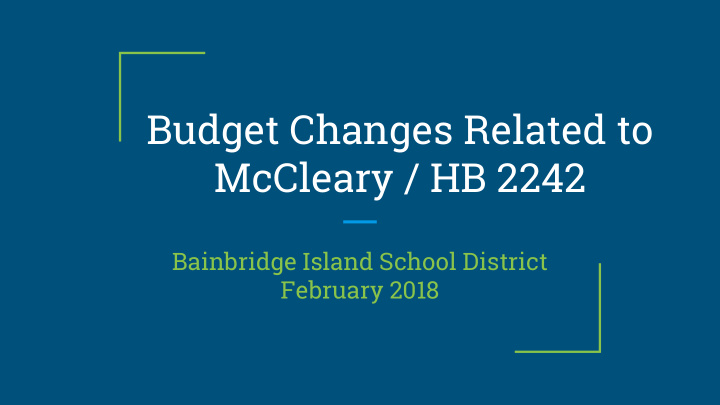



Budget Changes Related to McCleary / HB 2242 Bainbridge Island School District February 2018
Overview of Presentation Funding changes related to: ● ○ Salary and professional development Class size K-3 and Career and Technical Education (CTE) ○ ○ Programs Enrichment Levies ● Impact of changes to BISD ● ● Next steps in budget development
Changes in State Funding Formula Certificated Staff Professional Development BISD currently supports four days of professional development for certificated staff each year which are paid for through local levy support. The state will begin to provide funds for professional development days for certificated instructional staff. ● 2018-2019: 1 day paid by state ● 2019-2020: 2 days paid by state 2020-2021: 3 days paid by state ●
Salary ● Elimination of the state Salary Allocation Model (SAM). This will lead to a different salary schedule for certificated instructional staff in each of the 295 public school districts. The state will multiply the base amount funded by a district’s regionalization ● factor going from 0% to 18%. ( Tercile 3: 18% (BISD and the rest of Kitsap County has been designated in this category)
Salary Continued: State funding is provided through an allocation not a specific funding model. ● ● State salary allocations increase with ½ of the increase funded in the 2018-19 school year and the remaining portion in the 2019-20 school year. (Note: This is the primary element that the Supreme Court has tasked legislators with rectifying to allow full funding for 2018-19). ○ Certificated Instructional Staff (CIS) $64,000 per year identified base ($59,334 in 2018-19 and $64,000 in 2019-20) ■ ■ Districts may not pay CIS less than $40,000, or more than $90,000 (enhanced by regionalization factor). ○ Classified Staff (CLS) $45,912 per year identified base ($39,606 in 2018-19 and $45,912 in 2019-20) ■ ○ Certificated Administrative Staff (CAS) $95,000 per year identified base ($78,376 in 2018-19 and $95,000 in 2019-20) ■
Class Size for K-3 and CTE K-3 class sizes for state allocation comparison: Previous Model New Model ○ Kindergarten: 19 FTE 17 FTE ○ 1st Grade: 21 FTE 17 FTE ○ 2nd Grade: 22 FTE 17 FTE ○ 3rd Grade: 22 FTE 17 FTE ● This class size includes the classroom teacher and other specialists who provide instruction to the students. Average class sizes will be 2-3 students above the state average.* ● CTE class size is changing from 26.58 to 23 FTE. *Some programs may experience higher than average class sizes. ●
Programmatic Funding Changes ● Transitional Bilingual Program - referred to English Language Learners (ELL) ○ Small increase to support these learners Learning Assistance Program (LAP) ● ○ Small increase to support these learners ● Highly Capable Learners (Hi Cap) ○ Increase in the percent of students that districts can receive funding to provide services from 2.314% to 5% (Currently BISD identifies approximately 11% of students) Special Education Program (SpEd) ● ○ Increase in the percent of students that a district can receive funding to provide services for from 12.7% to 13.5% (Currently BISD identifies approximately 11.8% of students)
EP&O Levies Current Educational Program and Operations (EP&O) levy will be referred to as ● an Enrichment Levy, can only be used for non-basic educational costs, and are required to be specifically identified to the state. Districts will no longer have a maximum levy rate set by the state as a ● percentage of their state and federal funding (currently 28.9 for BISD) and can run a levy at the lower of the two thresholds: $1.50 per thousand dollars of assessed property value ○ ○ $2500 per pupil (this is the lower of the two for BISD)
Changes in Taxes 2018 The state school levy rate increases from $2.12 per $1000 to $3.03 per $1000 A transition year with no reductions imposed on local levy rates 2019 State school levy rate remains at $3.03 per thousand Local levy is reduced to the lesser of $1.50 per $1000 or $2500 per pupil $2500 per pupil is estimated to be $1.29 per $1000
Impact of Changes to BISD Essential opportunities that are now afforded to provide high levels of support and services for our students in the areas of: ● Recruiting and Retaining High Quality Staff ● Curriculum Needs ● Class size Support services for students and families ● ● Increase elective offerings ● Transportation
Changes in Funding **OSPI estimates changes to funding - all increases in state funding are approximations and are subject to change. Staffing (Certificated/Administrative/Classified): ~$4.1 million CTE (Staffing and Materials/Supplies): ~$550,000 Materials, Supplies, and Operating Costs: ~$68,000 Staffing for Programs (HiCap, ELL, LAP, SpEd): ~$600,000 Transportation: ~$220,000 Certificated Staff Professional Development (1 Day) ~$108,000 Decrease in EP&O Levy Collection: ~ - $144,000
● Increase of K-3 staffing by 6-8 instructors. ● Development of competitive compensation for staff in relation to state funding changes. Increase in Hi Cap funding of approximately $44,000 (occurred in 17-18). ● ● Small increases to LAP and ELL funding.
No increase to SpEd funding from the state. ● ● Reduction of ability to collect local levy funds - this will account for approximately a reduction from the 2018 levy collection of $10.4 million to $9.6 million over the next couple of years. Development of a budget that recognizes the changes in state funding and ● how they differ between the 2018-19 and 2019-20 school years.
Next Steps in Budget Development Presentation of changes and solicitation of input to staff, families, and the ● community. (January - March) https://goo.gl/wvrjf1 ● Determination of necessary staffing for the 2018-19 school year. (January - March) Collaborative discussions with collective bargaining units regarding ● changes in salary for the 2018-19 school year. (January - June) ● DBAC review of proposed budgetary changes. (January - May) Development of budget for 2018-19. (January - August) ●
Recommend
More recommend